“CNC Machining often comes with numerous pros. From automotive, aerospace, and consumer applications, its use is widespread in component manufacturing for these sectors. Moreover, it possesses similar features to metals to some extent. ”
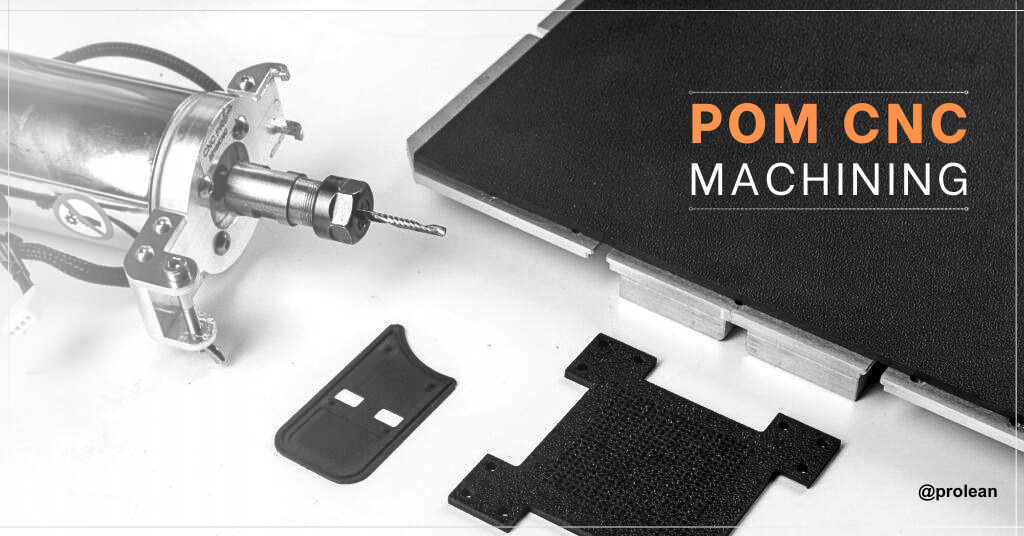
Polyoxymethylene or POM is a fascinating plastic resin found, extensively used in various industrial sectors. The aerospace, automotive, and electronics sectors are great consumers of this polymer. Polyoxymethylene machining notably enables fast and effective machining when employed for manufacturing prospects. Moreover, it benefits users because of its high mechanical strength, stiffness, workability, and diversity in terms of grade options.
This article entails the key details on POM CNC machining, and its grounded features in terms of capabilities, applications, merits, and so more. Let’s get into it.
What is POM? A Brief Overview
POM, a homopolymer, manufactured by DuPont company, possesses remarkable features. It is also identified by the name Delrin. It is widely adopted as engineered-grade thermoplastic for manufacturing prototypes for industrial use. It often comes in two forms: copolymer or homopolymer. From sophisticated prototypes to resilient machine parts, it benefits manufacturing industries economically.
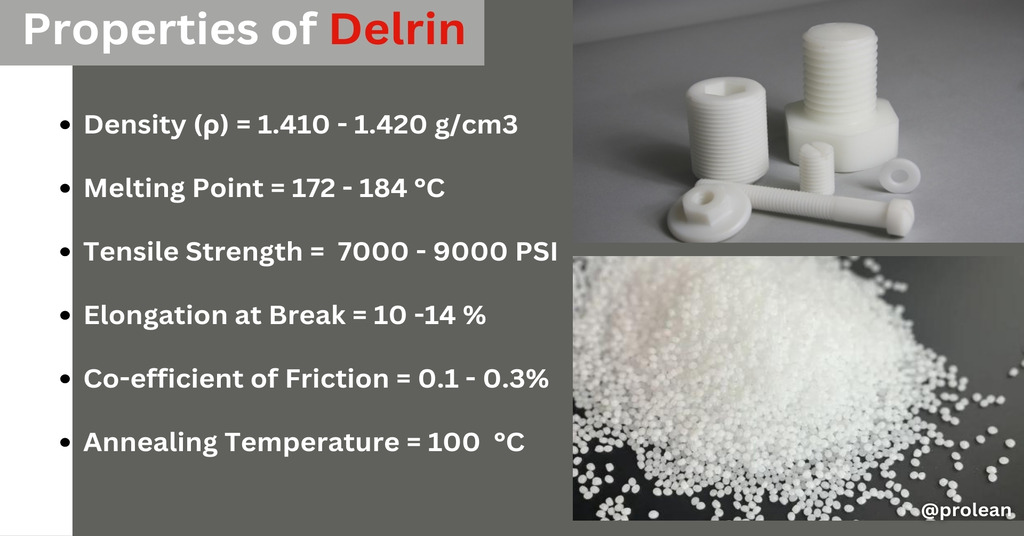
Material Properties of Derlin
Product designers can benefit from its structural integrity, color versatility, and stiffness properties. Moreover, its reliability and resilience in moist environments lend its applications to marine, medical, and aerospace use parts. POM, often known by some other names such as;
- Acetal (acetal),
- Polyacetal (polyacetal),
- Polyformaldehyde,
- Saigang
Try Prolean Now!
Why POM For CNC Machining?
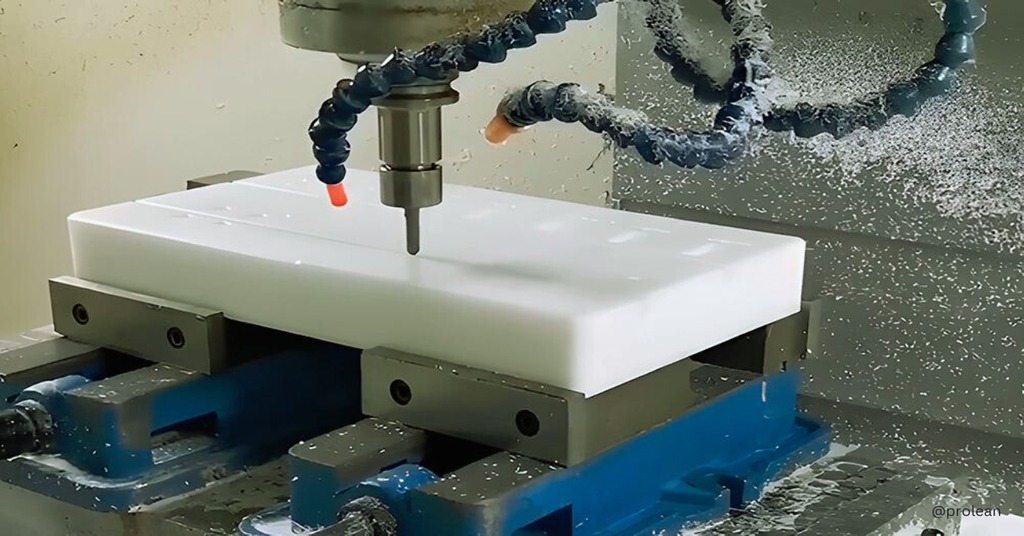
CNC Machining of POM
POM formaldehyde or polyacetal presents notable benefits when employed in machining. Thanks to leading-edge technologies like precision machining POM or CNC machining, such as milling, drilling, blanking, and punching, Moreover, its versatility in various grades is quite beneficial for machining experts. Delrin is also compatible with advanced cutting techniques; such as laser cutting and extrusion processes.
Some of the prime traits that make it sound for CNC machining include;
- It is lightweight, resistive to abrasion, and possesses low friction properties.
- The low frictional ability of POM dictates its use for high-precision rotating components such as bushes, bearings, and gears of automobiles.
- POM is similar to acrylic due to its intrinsic optical clarity and crystallinity.
- Delrin comes in various textures, colors, and grades.
- POM CNC machining is vital and effective for large-volume production runs.
- It has lower heat absorption rates than other grade polymers such as nylon and polyethylene.
- When it comes to CNC POM prototyping, CNC machining plays a key role in prototype formation.
- Delrine or POM is also known by other names metal plastic or super steel for its high rigidity and strength.
- POM can be milled, drilled, grooved, and cut effectively through CNC machining.
- Manufacturers can use it for versatile applications across aerospace, automotive, and consumer products.
- Design engineers can benefit from its dimensional stability and achieve tighter tolerances up to ±0.0005″.
- Rapid prototyping with CNC machining is viable.
- CNC lathes can also be exploited in POM Machining.
- It depicts low-cost solutions and provides economic benefits when exploited for large production volumes.
- POM is commonly employed by techniques; such as; CNC machining, injection molding, and 3D printing.
- Prototypes with complex geometries are easier to make through POM CNC machining.
Related To: Delrin CNC Machining: Everything You Need To Know
CNC Machining Methods For POM
Plastic CNC machining can be deployed by various techniques; for instance; CNC milling, CNC drilling, lathes, grinding, blanking, and punching. Its ease of machining greatly influences its use for these processes. Besides these, it gains significant attention for its high elongation %. Now, let’s discuss the ways to get the best optimal results out of POM CNC Machining.
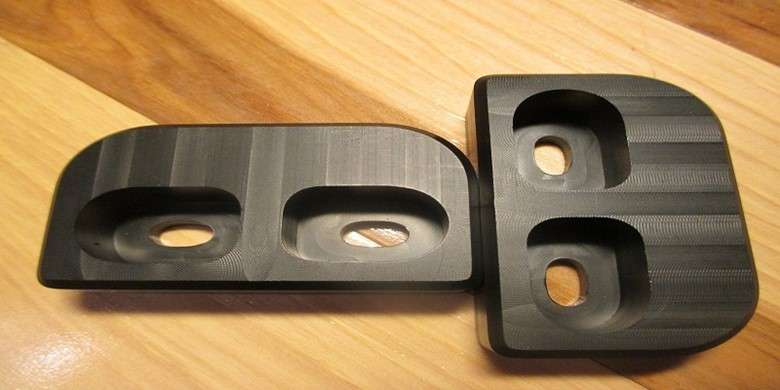
CNC-milled delrin parts
The process starts with computer-aided designs and programming to increase precision, quality, and optimization. After virtual configuration, instructions are forwarded to the CNC machine as G-Codes for further machining prospects.
Then, a cutting operation on the job material (POM) is performed to determine the optimal size and dimensions. Using coolants while machining Delrin at high speeds is recommended to prevent ineffective machining operations in terms of chip build-up or overheating.
Here are some techniques commonly employed to machine sturdy Polyoxymethylene or POM.
1. POM CNC Milling
CNC milling is frequently used to machine POM parts. Tools with sharp edges are useful for obtaining optimal angles, and surface finish. Therefore, the use of single-fluted mills is sound for the machining Delrin. These mills prevent chip build-up during machining operations.
2. POM CNC Drilling
Standard twist and center drills are best suited to machine Delrin. These exhibit strong, ground-inflated sharp edges that ultimately lead to smooth milling operations on Delrin. The optimal cutting speed for drilling POM must be around 1500 rpm, with a lip angle of twist 118°.
3. POM CNC Turning
POM CNC turning operation resembles brass turning operation. The best possible outcomes can be achieved by keeping a high turning speed identical to medium feed rates. To prevent interference and excessive chip-build-up issues, it’s imperative to use chip breakers for precision turning operation.
4. Blanking & Punching
Blanking and punching are both go-to options for small- to medium-sized intricate parts. During operation, sheet cracking can cause a leading issue for inappropriate machining. It’s best to preheat the Delrin sheet and use a manual or high-piercing punch to eradicate this issue.
Key Note: “It is important to keep tight or hold POM and use hard steel, or carbide tools during CNC machining of POM.”
Related To: CNC Machining For Thermoplastics: A Comprehensive Guide
Delrin Grades At A Glance For CNC Machining
Two of the most common acetal grades are of great use for CNC machining: Delrin 150 and Delrin 100 (AF). Let’s evaluate their compatibility;
1. Acetal (Delrin) 150
Derlin 150 belongs to the acetal homopolymer family. It has high mechanical strength, stiffness, and abrasion resistance. Due to these peculiar characteristics, it’s an ideal choice for CNC machining for gears, bushings, gaskets, and automotive interiors & exteriors. Moreover, its stability in high thermal conditions makes it sound for irrigation and conveyor components.
2. Acetal (Delrin) 100 (A)
Delrin 100 A is integrated with Teflon (PTFE) to enhance mechanical stability and viscosity. It finds extensive use in gearing systems or components that require low frictional properties. Moreover, it is very resistant to moisture and chemicals. Moreover, it extinguishes a self-lubrication (oil or grease) feature to distinguish it from other Delrin grades.
Surface Finishing Options For POM
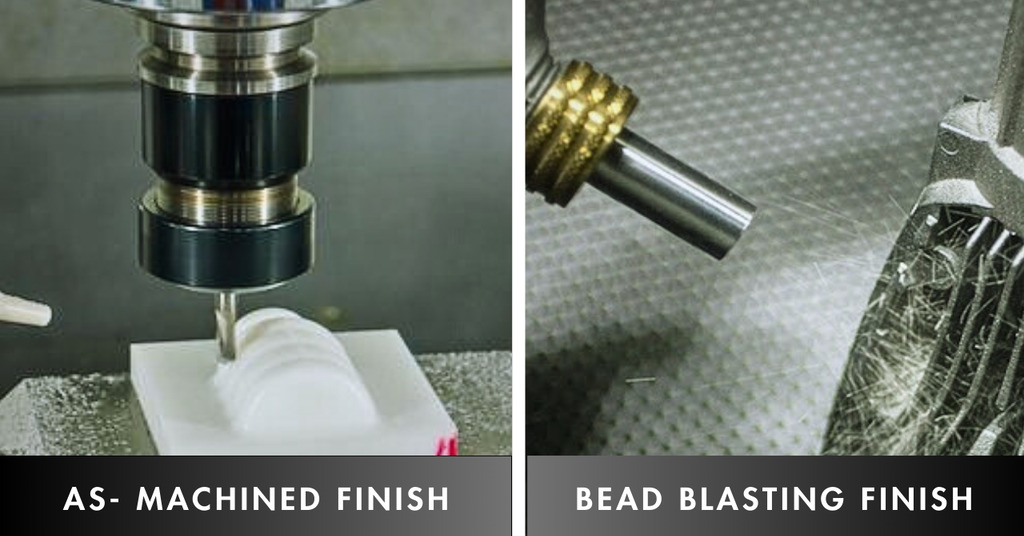
Surface Finishing of POM
The desired surface finish plays a vital role during the machining process. Two options are commonly employed regarding surface finishing: As-machined & bead blasting. Here’s a short brief of these;
As Machined
CNC machining often leaves rugged surfaces or textures on the surface of acetal parts. An as-machined finish is preferred where rugged or textured parts are needed to improve the frictional properties of components. The typical range of roughness that can be achieved by machining is around 32 to 250 microinches (0.8 to 6.3 micrometers).
Bead Blast
In most cases, machining tools spot marks on acetal parts. Bead blasting is generally applied to prevent tool marks and enhance the visuals of the Delrin machined part. It releases glass beads or fine particles to the machined part surface under high pressure. Moreover, it improves durability and offers an invaluable, smooth, matte, aesthetic, and satin polish look to delrin machine parts.
There are other techniques, too, such as anodizing, polishing, painting, and hot stamping. However, due to their economic viability, most design engineers prefer the two mentioned above.
Try Prolean Now!
What are the Limitations of Delrin CNC Machining?
However, there are huge benefits to employing Delrin for CNC machining. Alongside, it also comes with a few downsides. Here are the limitations of Delrin;
- Adhesion: Although acetal possesses great chemical resistance but tends to incur challenges during bonding with strong adhesives. To overcome this, designers may need to go for post-processing surface options for optimal benefits.
- Heat Sensitive: Heat sensitivity is a notable concern for design manufacturers. Acetol’s ability to withstand high thermal conditions is quite notable. However, it’s ideal for applications where mechanical stability is paramount. But in some cases, when it gets exposed to high-temperature conditions, it permits deformation or distortion issues. In comparison with nylon, nylon exhibits more strength and structural strength even in harsh environments.
- High Flammability: Machining delrin poses challenges of flammability. It’s sensitive to temperatures above 121 degrees Celsius. It’s recommended to always use coolants such as air-based coolants to maintain temperatures during machining operations. To overcome or control flammability issues, it’s also necessary to use class A fire extinguishers while machining POM.
Applications of Delrin CNC Machining
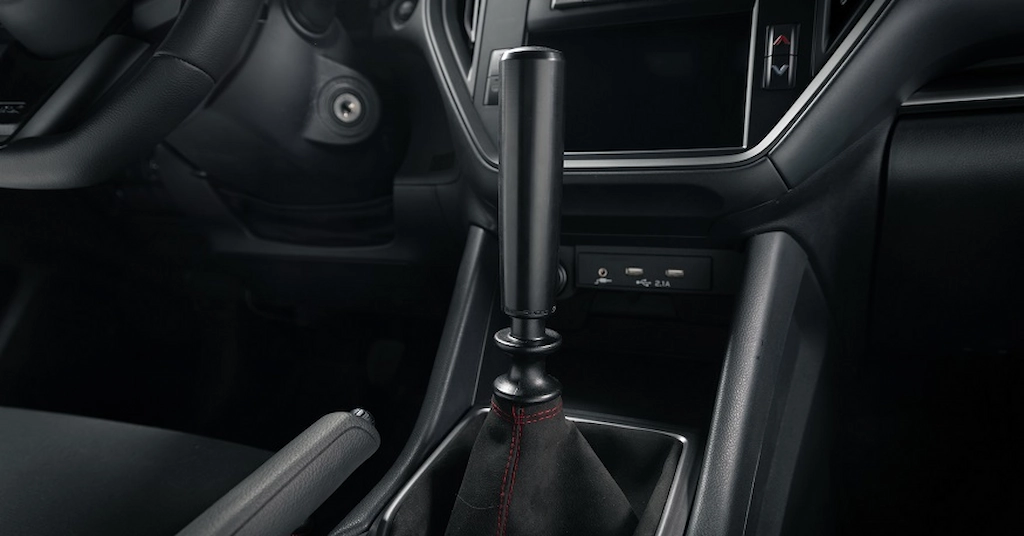
Delrin automotive application
From auto interiors & exteriors to aerospace components, Derlin’s applications are so widespread. Let’s find out some of its key applications across manufacturing sectors;
Medical
POM is of great use material for medical components or devices. Being an engineered thermoplastic, it comes compatible with stringent quality standards of the FDA or ISO. It spans its applications from housing and enclosure to intricate feature components; such as; disposable syringes, surgical tools, valves, inhalers, prosthetics & medical implants.
Automotive
Derlin facilitates several automotive parts to the automotive sectors. Its high mechanical strength, low friction, and resistance to wear and tear, characteristics enable engineers to use it for manufacturing essential cars, motorbikes, and electric vehicle components. Some common examples include; articulated shells, lock systems, and fuel sender units.
Consume Appliances
Polyoxymethylene machining has several notable benefits for handy applications. Manufacturing experts use it to make zippers, cooking appliances, washing machines, and clips.
Industrial Mechanical Parts
Derlin’s tremendous strength permits its use across industrial parts manufacturing. Its ability to withstand wear and tear and low frictional property makes it ideal for components like springs, fan wheels, gears, enclosures, scrappers, and rollers.
Read more:
- Everything You Need To Know About CNC Machining
- Common Materials For CNC Machining
- Best Cutting Tools For CNC Machining: Choose The Right
Plastic CNC Machining Services at Prolean
Prolean stands at the forefront of CNC Plastic machining services. Our comprehensive support will help you produce the best outputs in your intended project within your constrained budget. Moreover, our faculty offers you abundant plastic material options. Whether you need Delrin-made parts or other sturdy plastic components, we offer a great space.
Our dedicated team of experts ensures smoothness, precision, and performance by supporting our customers from start to finish in your project needs.
Contact us today for a high surface quality finish and get a free instant quote tailored to your requirements.
Try Prolean Now!
Summing Up
POM CNC Machining, or Polyoxymethylene machining, has gained significant attention for its reliability, effectiveness, precision, and accuracy in part fabrication. Delrin, a strong, durable component, paves the way to fulfilling the needs of several industrial sectors. It allows design engineers to fabricate detailed feature components, from handy devices to large machining auxiliaries.
However, there are a few challenges that should be kept in mind. For example, non-compatibility with high thermal conditions and flammability limits its use to some extent. In this way, carefulness and controlled operational conditions should be adopted for desired outcomes.
To make your project stand above expectations, it is recommended to consult with professionals. Guidance from experts helps you through every complexity that comes your way in your machining project.
FAQs
Q1. What are the CNC Plastics other than Delrin?
There are several other engineered thermoplastic grades for CNC machining other than acetal.
- ABS CNC Machining
- Delrin Machining
- Nylon
- Acrylic
- Polyethylene
Q2. Alternatives to machine Delrin than CNC machining?
You can go for other techniques to machine Delrin for prototyping or other intended needs. These include;
- Injection Molding Delrin
- 3D Printing Delrin
- Extrusion Techniques
Among these, injection molding is considerably known for its cost-effectiveness when employed for large-volume production runs.
Q3. Is CNC machining good for rapid prototyping?
Yes, CNC machining is considered an effective method to machine prototypes for various sectors, including automotive, aerospace, consumer appliances, etc.
Q4. Which country offers the best solutions for POM machining prototyping?
China is considered the best provider of polyoxymethylene machining services across the globe. It provides precision machining POM solutions to all over the world.
Q5. Why is CNC machining considered the most effective for thermoplastics machining?
CNC machining imparts more benefits when machining different thermoplastic materials. The reason lies in its quickest approach with precision and accuracy all while in a minimum turnaround. Moreover, quick prototyping can be achieved by exploiting CNC machining in operation.
Q6. What grades of POM are best suited to CNC machining?
Delrin normally comes in various forms, each offering a set of benefits and limitations. The most commonly used Delrin grades are;
- FDA Compliant acetol or delrin
- PTFE Filled Acetal
- Glass Reinforced Acetals
Q7. Can Delrin (POM) withstand harsh operating conditions?
Delrin offers high dimensional stability and performs well when employed in highly acidic or thermal conditions. The optimum operating temperature should be not more or less -40°C to 120°C.
Q8. What are the common issues caused during POM CNC machining?
Machining Delrin often comes with certain challenges; including; whipping, adhesion, bondability, and heat sensitivity when exposed to high thermal conditions.
Resources
- K. Pielichowska, (2015)in Manufacturing of Nanocomposites with Engineering, From Encyclopedia of Electrochemical Power Source: Retrieved From Science Direct.
- R. Keresztes, G. Kalácska, L. Zsidai, Z. Dobrocs, (Nov 2011), Machinability of engineering Polymers: Retrieved From: ResearchGate




0 Comments